Western Sydney University: Renewable Energy Research Proposal (301004)
VerifiedAdded on 2022/09/16
|8
|1947
|21
Report
AI Summary
This research proposal examines the impact of renewable energy in Australia, focusing on its benefits and drawbacks. It explores the concept of renewable energy, including sources like wind, solar, and hydroelectricity, and discusses its increasing importance globally. The report details the use of renewable energy in Australia, highlighting the country's achievements in meeting renewable energy targets and the various renewable energy sources employed. It also addresses factors affecting the use of renewable energy, such as government policies, grid connection costs, and social and economic influences. The proposal concludes that renewable energy has a positive impact on Australia, promoting long-term cost savings and environmental sustainability. The report uses peer-reviewed papers and provides a full bibliography and correct citations as per the assignment brief.
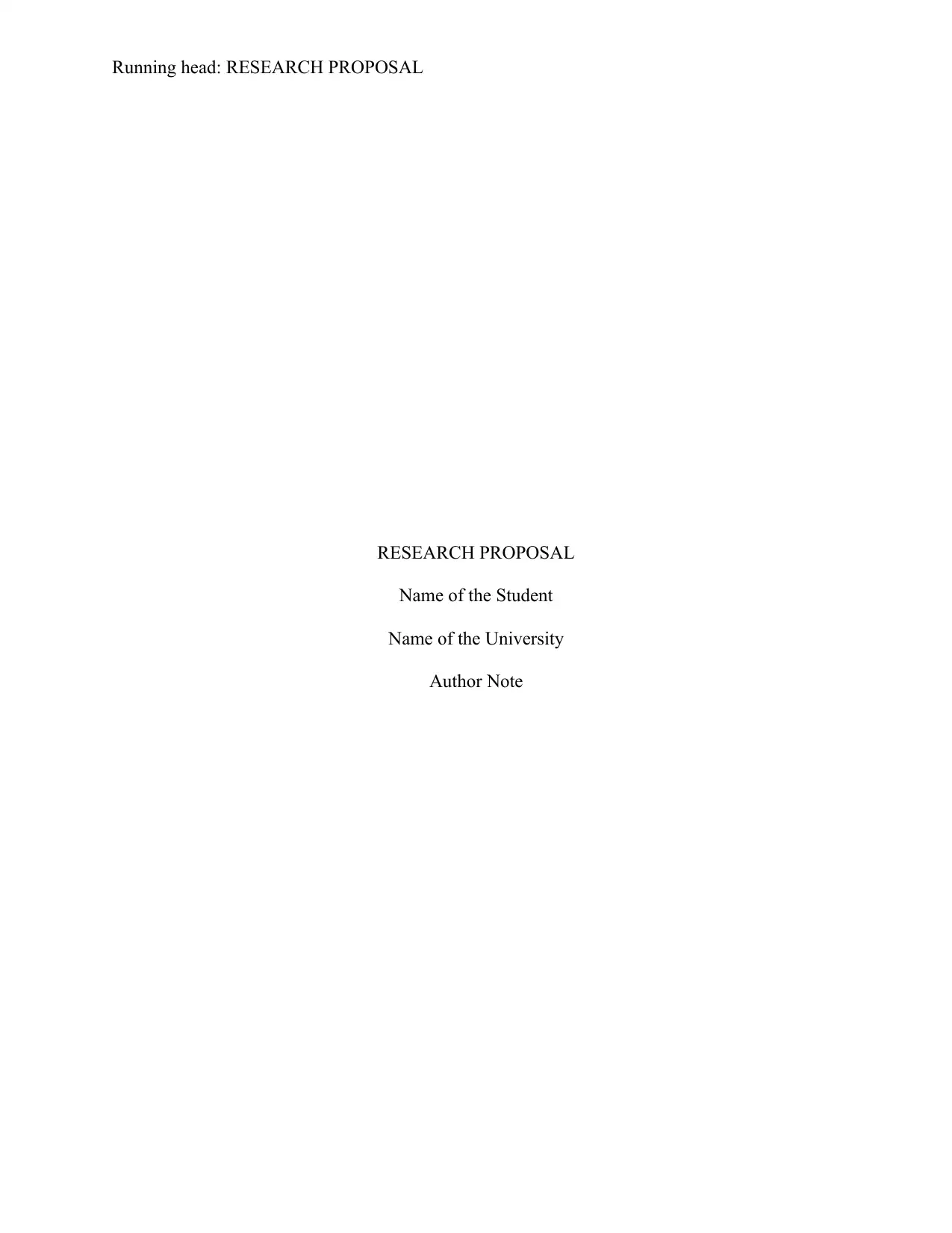
Running head: RESEARCH PROPOSAL
RESEARCH PROPOSAL
Name of the Student
Name of the University
Author Note
RESEARCH PROPOSAL
Name of the Student
Name of the University
Author Note
Paraphrase This Document
Need a fresh take? Get an instant paraphrase of this document with our AI Paraphraser
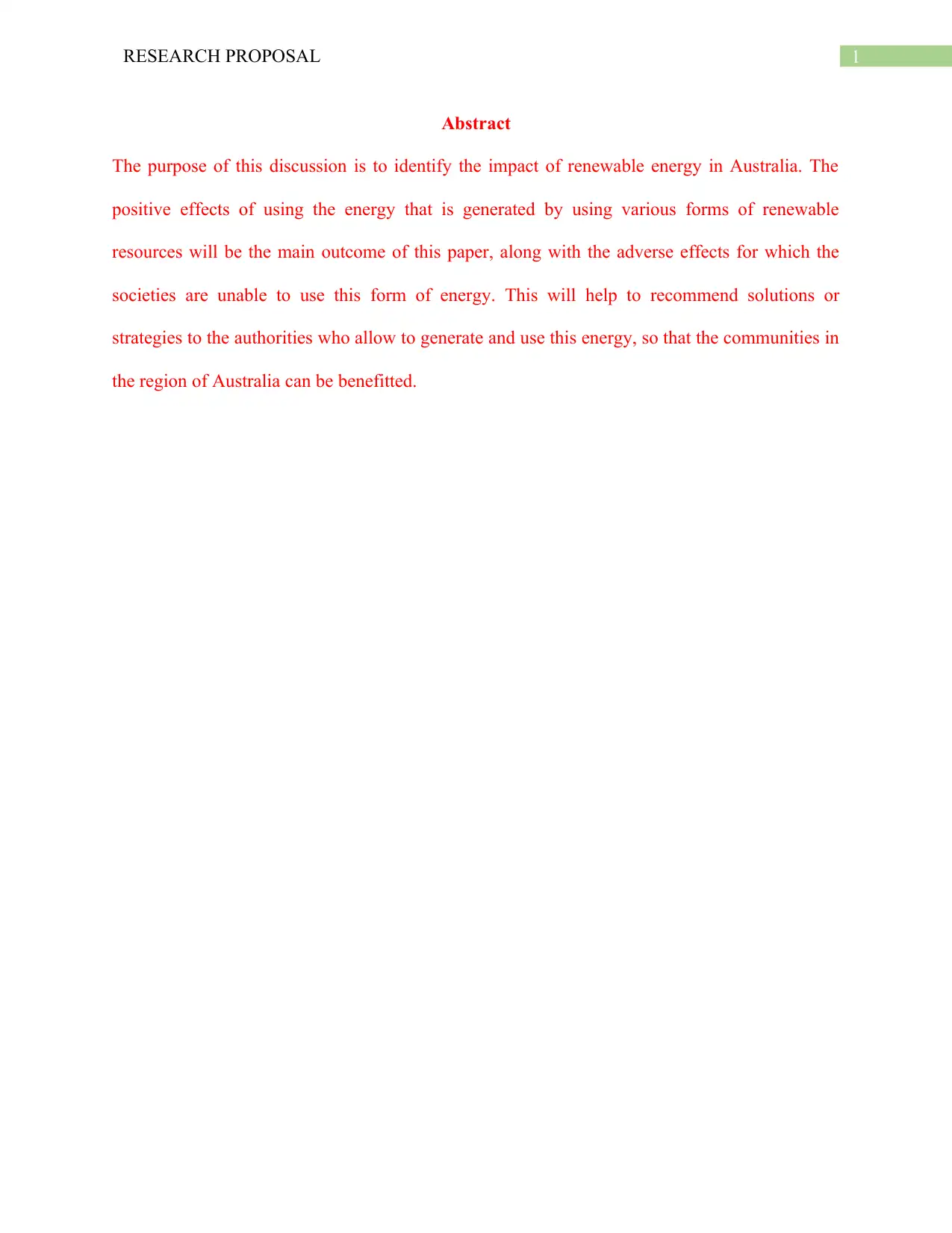
1RESEARCH PROPOSAL
Abstract
The purpose of this discussion is to identify the impact of renewable energy in Australia. The
positive effects of using the energy that is generated by using various forms of renewable
resources will be the main outcome of this paper, along with the adverse effects for which the
societies are unable to use this form of energy. This will help to recommend solutions or
strategies to the authorities who allow to generate and use this energy, so that the communities in
the region of Australia can be benefitted.
Abstract
The purpose of this discussion is to identify the impact of renewable energy in Australia. The
positive effects of using the energy that is generated by using various forms of renewable
resources will be the main outcome of this paper, along with the adverse effects for which the
societies are unable to use this form of energy. This will help to recommend solutions or
strategies to the authorities who allow to generate and use this energy, so that the communities in
the region of Australia can be benefitted.
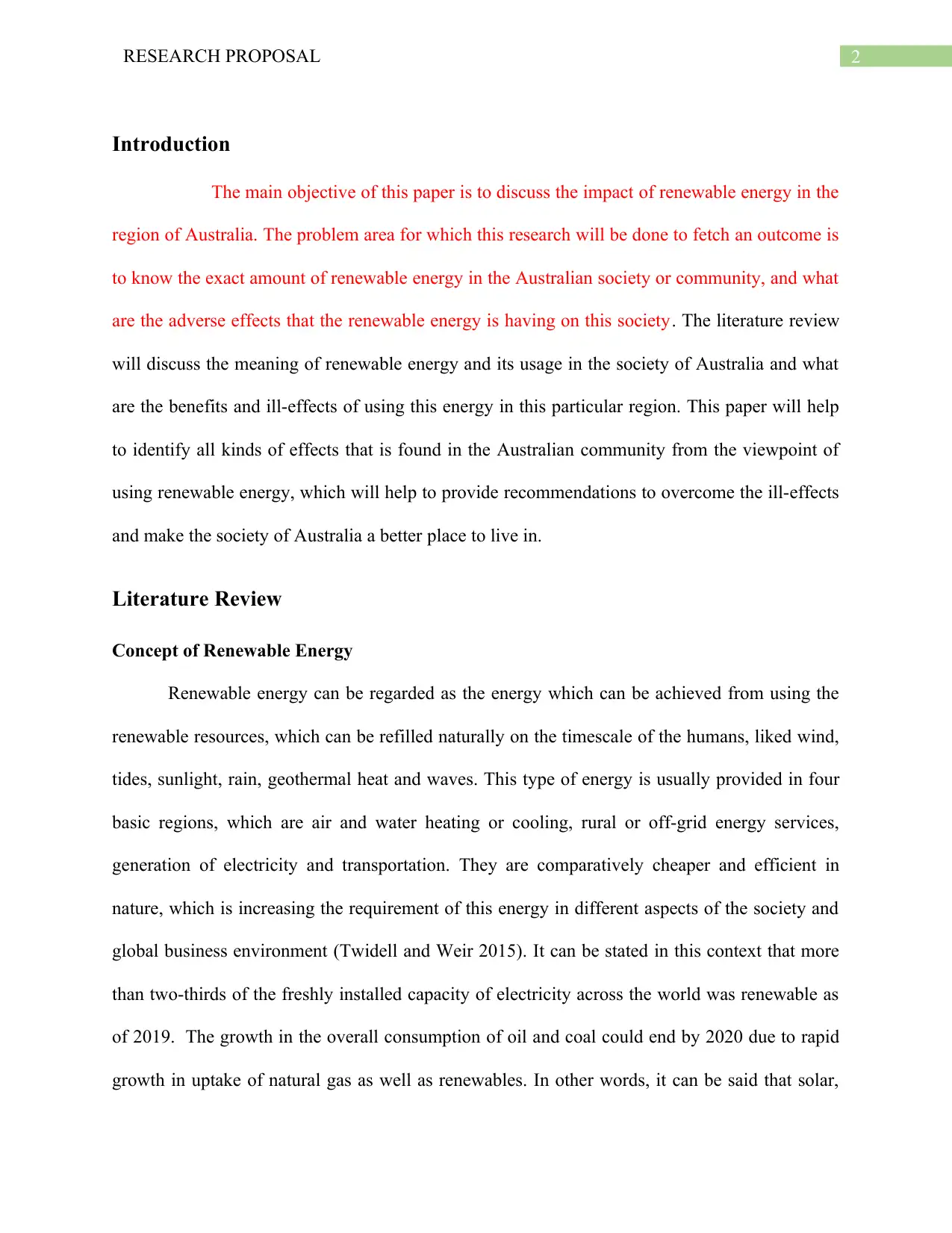
2RESEARCH PROPOSAL
Introduction
The main objective of this paper is to discuss the impact of renewable energy in the
region of Australia. The problem area for which this research will be done to fetch an outcome is
to know the exact amount of renewable energy in the Australian society or community, and what
are the adverse effects that the renewable energy is having on this society. The literature review
will discuss the meaning of renewable energy and its usage in the society of Australia and what
are the benefits and ill-effects of using this energy in this particular region. This paper will help
to identify all kinds of effects that is found in the Australian community from the viewpoint of
using renewable energy, which will help to provide recommendations to overcome the ill-effects
and make the society of Australia a better place to live in.
Literature Review
Concept of Renewable Energy
Renewable energy can be regarded as the energy which can be achieved from using the
renewable resources, which can be refilled naturally on the timescale of the humans, liked wind,
tides, sunlight, rain, geothermal heat and waves. This type of energy is usually provided in four
basic regions, which are air and water heating or cooling, rural or off-grid energy services,
generation of electricity and transportation. They are comparatively cheaper and efficient in
nature, which is increasing the requirement of this energy in different aspects of the society and
global business environment (Twidell and Weir 2015). It can be stated in this context that more
than two-thirds of the freshly installed capacity of electricity across the world was renewable as
of 2019. The growth in the overall consumption of oil and coal could end by 2020 due to rapid
growth in uptake of natural gas as well as renewables. In other words, it can be said that solar,
Introduction
The main objective of this paper is to discuss the impact of renewable energy in the
region of Australia. The problem area for which this research will be done to fetch an outcome is
to know the exact amount of renewable energy in the Australian society or community, and what
are the adverse effects that the renewable energy is having on this society. The literature review
will discuss the meaning of renewable energy and its usage in the society of Australia and what
are the benefits and ill-effects of using this energy in this particular region. This paper will help
to identify all kinds of effects that is found in the Australian community from the viewpoint of
using renewable energy, which will help to provide recommendations to overcome the ill-effects
and make the society of Australia a better place to live in.
Literature Review
Concept of Renewable Energy
Renewable energy can be regarded as the energy which can be achieved from using the
renewable resources, which can be refilled naturally on the timescale of the humans, liked wind,
tides, sunlight, rain, geothermal heat and waves. This type of energy is usually provided in four
basic regions, which are air and water heating or cooling, rural or off-grid energy services,
generation of electricity and transportation. They are comparatively cheaper and efficient in
nature, which is increasing the requirement of this energy in different aspects of the society and
global business environment (Twidell and Weir 2015). It can be stated in this context that more
than two-thirds of the freshly installed capacity of electricity across the world was renewable as
of 2019. The growth in the overall consumption of oil and coal could end by 2020 due to rapid
growth in uptake of natural gas as well as renewables. In other words, it can be said that solar,
⊘ This is a preview!⊘
Do you want full access?
Subscribe today to unlock all pages.

Trusted by 1+ million students worldwide
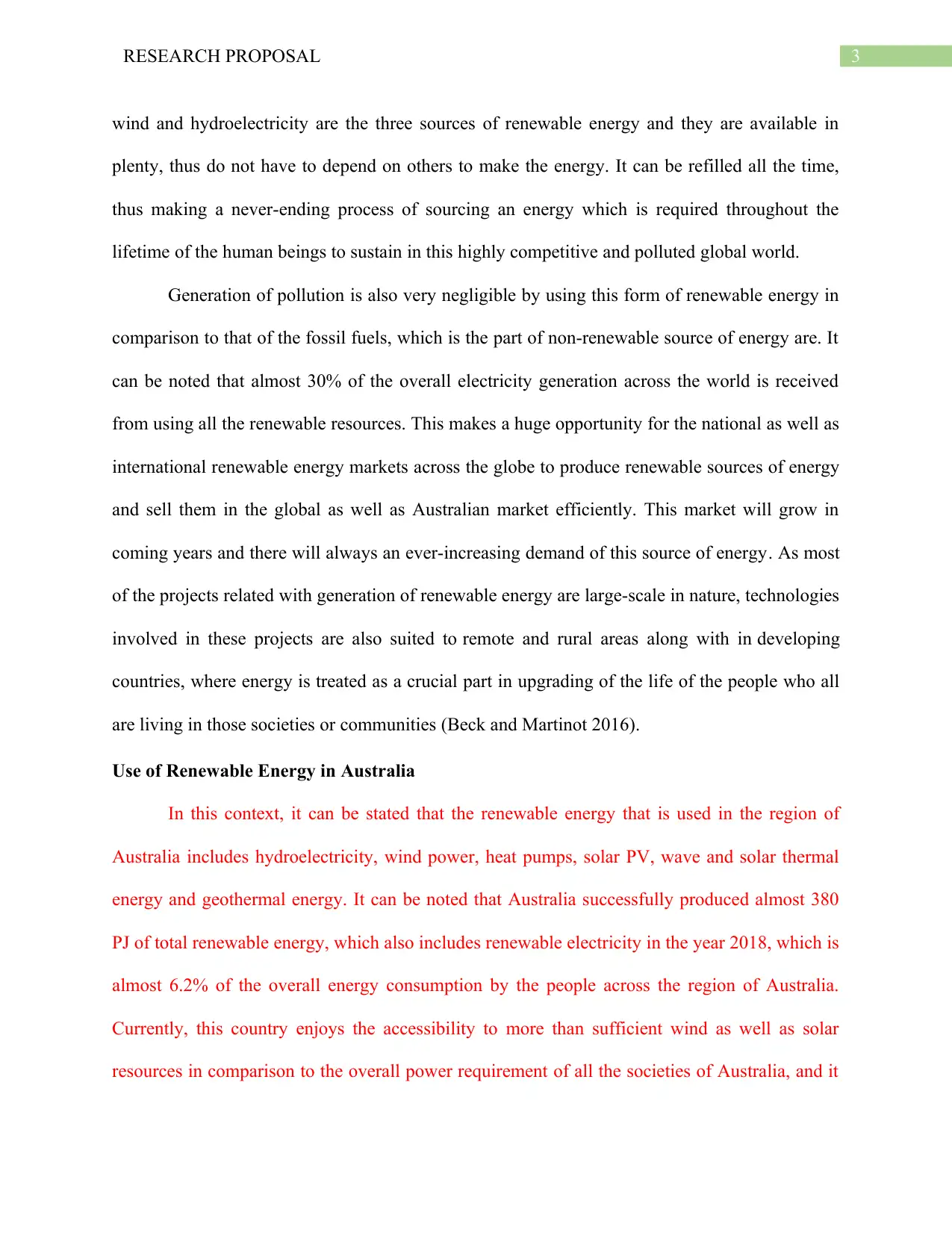
3RESEARCH PROPOSAL
wind and hydroelectricity are the three sources of renewable energy and they are available in
plenty, thus do not have to depend on others to make the energy. It can be refilled all the time,
thus making a never-ending process of sourcing an energy which is required throughout the
lifetime of the human beings to sustain in this highly competitive and polluted global world.
Generation of pollution is also very negligible by using this form of renewable energy in
comparison to that of the fossil fuels, which is the part of non-renewable source of energy are. It
can be noted that almost 30% of the overall electricity generation across the world is received
from using all the renewable resources. This makes a huge opportunity for the national as well as
international renewable energy markets across the globe to produce renewable sources of energy
and sell them in the global as well as Australian market efficiently. This market will grow in
coming years and there will always an ever-increasing demand of this source of energy. As most
of the projects related with generation of renewable energy are large-scale in nature, technologies
involved in these projects are also suited to remote and rural areas along with in developing
countries, where energy is treated as a crucial part in upgrading of the life of the people who all
are living in those societies or communities (Beck and Martinot 2016).
Use of Renewable Energy in Australia
In this context, it can be stated that the renewable energy that is used in the region of
Australia includes hydroelectricity, wind power, heat pumps, solar PV, wave and solar thermal
energy and geothermal energy. It can be noted that Australia successfully produced almost 380
PJ of total renewable energy, which also includes renewable electricity in the year 2018, which is
almost 6.2% of the overall energy consumption by the people across the region of Australia.
Currently, this country enjoys the accessibility to more than sufficient wind as well as solar
resources in comparison to the overall power requirement of all the societies of Australia, and it
wind and hydroelectricity are the three sources of renewable energy and they are available in
plenty, thus do not have to depend on others to make the energy. It can be refilled all the time,
thus making a never-ending process of sourcing an energy which is required throughout the
lifetime of the human beings to sustain in this highly competitive and polluted global world.
Generation of pollution is also very negligible by using this form of renewable energy in
comparison to that of the fossil fuels, which is the part of non-renewable source of energy are. It
can be noted that almost 30% of the overall electricity generation across the world is received
from using all the renewable resources. This makes a huge opportunity for the national as well as
international renewable energy markets across the globe to produce renewable sources of energy
and sell them in the global as well as Australian market efficiently. This market will grow in
coming years and there will always an ever-increasing demand of this source of energy. As most
of the projects related with generation of renewable energy are large-scale in nature, technologies
involved in these projects are also suited to remote and rural areas along with in developing
countries, where energy is treated as a crucial part in upgrading of the life of the people who all
are living in those societies or communities (Beck and Martinot 2016).
Use of Renewable Energy in Australia
In this context, it can be stated that the renewable energy that is used in the region of
Australia includes hydroelectricity, wind power, heat pumps, solar PV, wave and solar thermal
energy and geothermal energy. It can be noted that Australia successfully produced almost 380
PJ of total renewable energy, which also includes renewable electricity in the year 2018, which is
almost 6.2% of the overall energy consumption by the people across the region of Australia.
Currently, this country enjoys the accessibility to more than sufficient wind as well as solar
resources in comparison to the overall power requirement of all the societies of Australia, and it
Paraphrase This Document
Need a fresh take? Get an instant paraphrase of this document with our AI Paraphraser
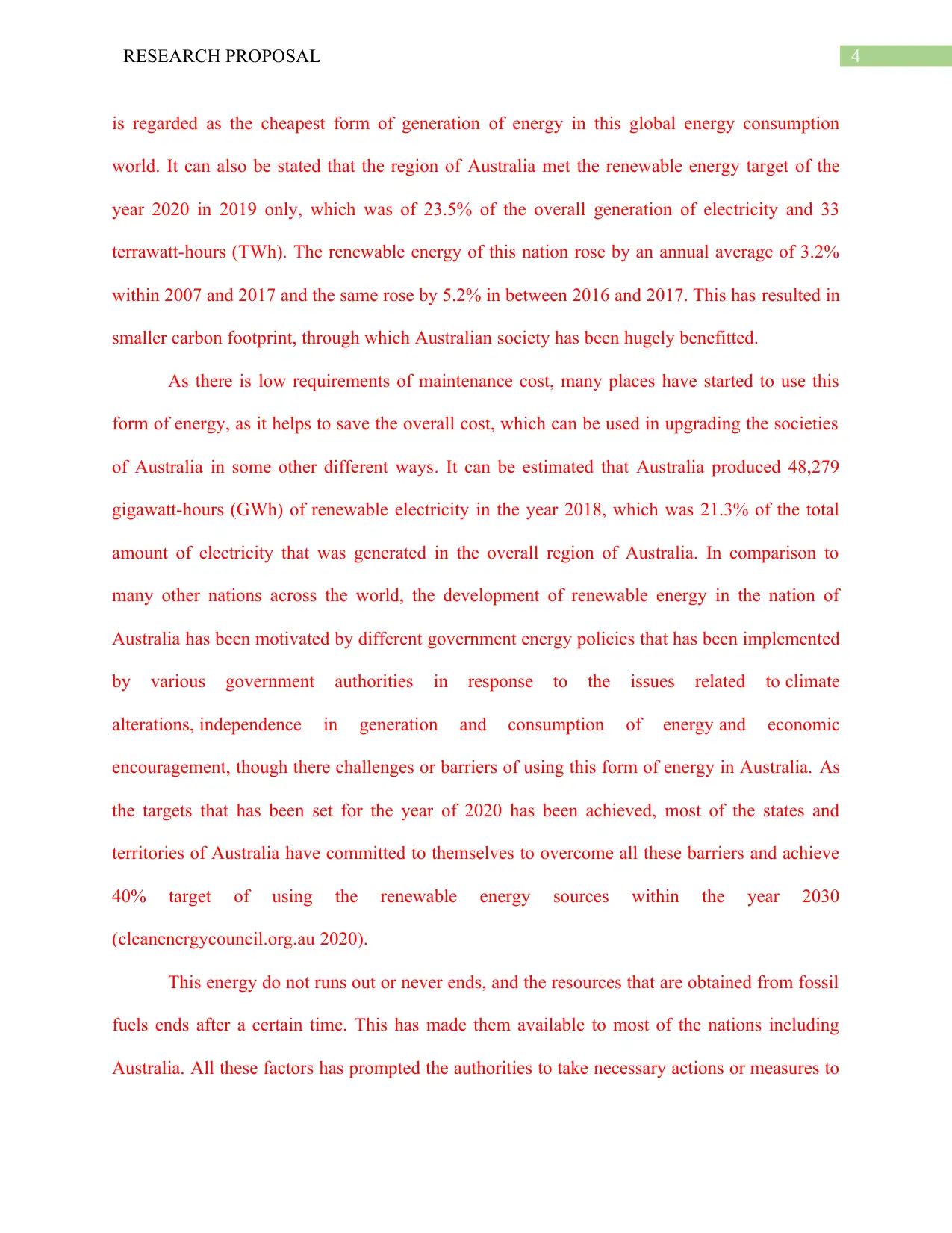
4RESEARCH PROPOSAL
is regarded as the cheapest form of generation of energy in this global energy consumption
world. It can also be stated that the region of Australia met the renewable energy target of the
year 2020 in 2019 only, which was of 23.5% of the overall generation of electricity and 33
terrawatt-hours (TWh). The renewable energy of this nation rose by an annual average of 3.2%
within 2007 and 2017 and the same rose by 5.2% in between 2016 and 2017. This has resulted in
smaller carbon footprint, through which Australian society has been hugely benefitted.
As there is low requirements of maintenance cost, many places have started to use this
form of energy, as it helps to save the overall cost, which can be used in upgrading the societies
of Australia in some other different ways. It can be estimated that Australia produced 48,279
gigawatt-hours (GWh) of renewable electricity in the year 2018, which was 21.3% of the total
amount of electricity that was generated in the overall region of Australia. In comparison to
many other nations across the world, the development of renewable energy in the nation of
Australia has been motivated by different government energy policies that has been implemented
by various government authorities in response to the issues related to climate
alterations, independence in generation and consumption of energy and economic
encouragement, though there challenges or barriers of using this form of energy in Australia. As
the targets that has been set for the year of 2020 has been achieved, most of the states and
territories of Australia have committed to themselves to overcome all these barriers and achieve
40% target of using the renewable energy sources within the year 2030
(cleanenergycouncil.org.au 2020).
This energy do not runs out or never ends, and the resources that are obtained from fossil
fuels ends after a certain time. This has made them available to most of the nations including
Australia. All these factors has prompted the authorities to take necessary actions or measures to
is regarded as the cheapest form of generation of energy in this global energy consumption
world. It can also be stated that the region of Australia met the renewable energy target of the
year 2020 in 2019 only, which was of 23.5% of the overall generation of electricity and 33
terrawatt-hours (TWh). The renewable energy of this nation rose by an annual average of 3.2%
within 2007 and 2017 and the same rose by 5.2% in between 2016 and 2017. This has resulted in
smaller carbon footprint, through which Australian society has been hugely benefitted.
As there is low requirements of maintenance cost, many places have started to use this
form of energy, as it helps to save the overall cost, which can be used in upgrading the societies
of Australia in some other different ways. It can be estimated that Australia produced 48,279
gigawatt-hours (GWh) of renewable electricity in the year 2018, which was 21.3% of the total
amount of electricity that was generated in the overall region of Australia. In comparison to
many other nations across the world, the development of renewable energy in the nation of
Australia has been motivated by different government energy policies that has been implemented
by various government authorities in response to the issues related to climate
alterations, independence in generation and consumption of energy and economic
encouragement, though there challenges or barriers of using this form of energy in Australia. As
the targets that has been set for the year of 2020 has been achieved, most of the states and
territories of Australia have committed to themselves to overcome all these barriers and achieve
40% target of using the renewable energy sources within the year 2030
(cleanenergycouncil.org.au 2020).
This energy do not runs out or never ends, and the resources that are obtained from fossil
fuels ends after a certain time. This has made them available to most of the nations including
Australia. All these factors has prompted the authorities to take necessary actions or measures to
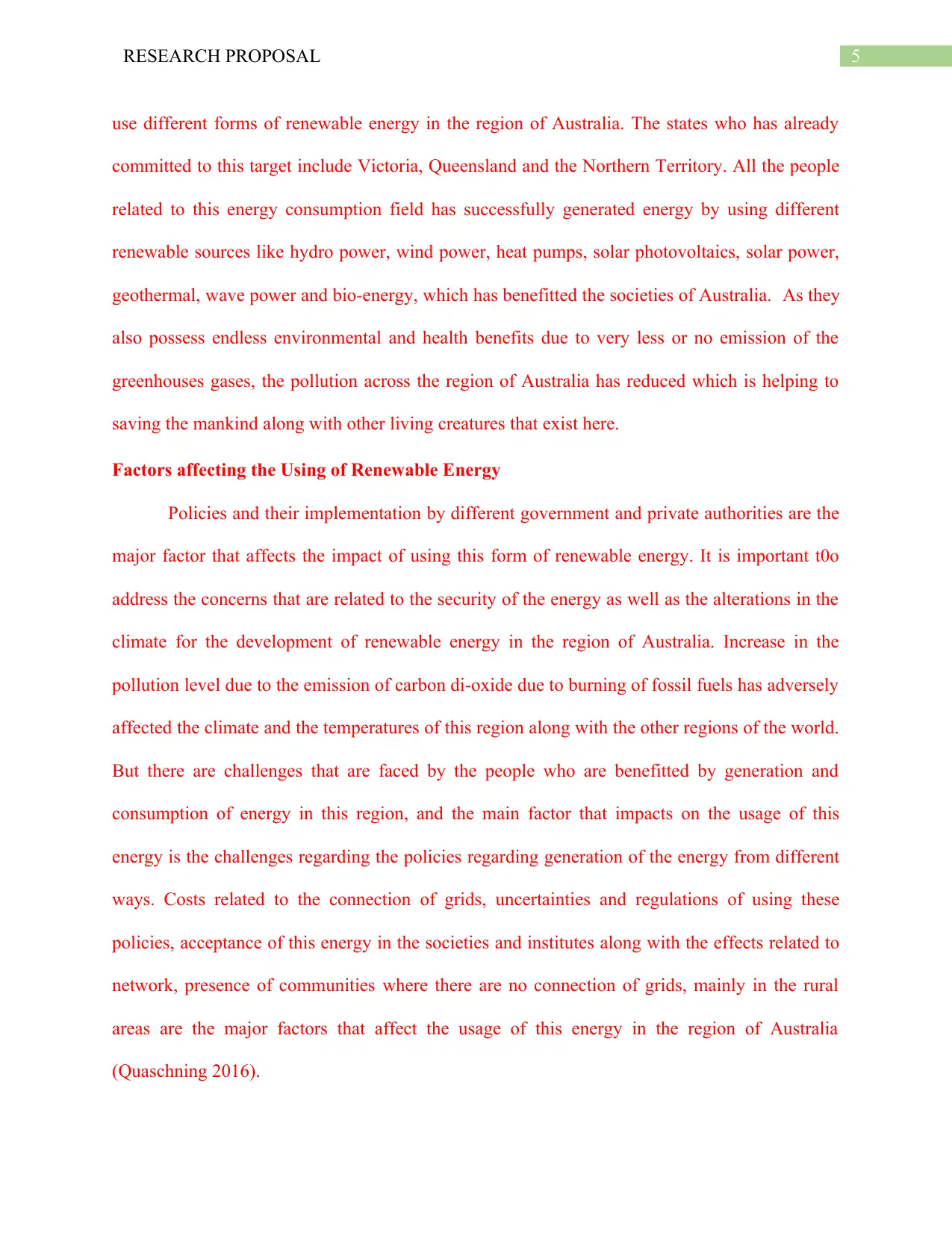
5RESEARCH PROPOSAL
use different forms of renewable energy in the region of Australia. The states who has already
committed to this target include Victoria, Queensland and the Northern Territory. All the people
related to this energy consumption field has successfully generated energy by using different
renewable sources like hydro power, wind power, heat pumps, solar photovoltaics, solar power,
geothermal, wave power and bio-energy, which has benefitted the societies of Australia. As they
also possess endless environmental and health benefits due to very less or no emission of the
greenhouses gases, the pollution across the region of Australia has reduced which is helping to
saving the mankind along with other living creatures that exist here.
Factors affecting the Using of Renewable Energy
Policies and their implementation by different government and private authorities are the
major factor that affects the impact of using this form of renewable energy. It is important t0o
address the concerns that are related to the security of the energy as well as the alterations in the
climate for the development of renewable energy in the region of Australia. Increase in the
pollution level due to the emission of carbon di-oxide due to burning of fossil fuels has adversely
affected the climate and the temperatures of this region along with the other regions of the world.
But there are challenges that are faced by the people who are benefitted by generation and
consumption of energy in this region, and the main factor that impacts on the usage of this
energy is the challenges regarding the policies regarding generation of the energy from different
ways. Costs related to the connection of grids, uncertainties and regulations of using these
policies, acceptance of this energy in the societies and institutes along with the effects related to
network, presence of communities where there are no connection of grids, mainly in the rural
areas are the major factors that affect the usage of this energy in the region of Australia
(Quaschning 2016).
use different forms of renewable energy in the region of Australia. The states who has already
committed to this target include Victoria, Queensland and the Northern Territory. All the people
related to this energy consumption field has successfully generated energy by using different
renewable sources like hydro power, wind power, heat pumps, solar photovoltaics, solar power,
geothermal, wave power and bio-energy, which has benefitted the societies of Australia. As they
also possess endless environmental and health benefits due to very less or no emission of the
greenhouses gases, the pollution across the region of Australia has reduced which is helping to
saving the mankind along with other living creatures that exist here.
Factors affecting the Using of Renewable Energy
Policies and their implementation by different government and private authorities are the
major factor that affects the impact of using this form of renewable energy. It is important t0o
address the concerns that are related to the security of the energy as well as the alterations in the
climate for the development of renewable energy in the region of Australia. Increase in the
pollution level due to the emission of carbon di-oxide due to burning of fossil fuels has adversely
affected the climate and the temperatures of this region along with the other regions of the world.
But there are challenges that are faced by the people who are benefitted by generation and
consumption of energy in this region, and the main factor that impacts on the usage of this
energy is the challenges regarding the policies regarding generation of the energy from different
ways. Costs related to the connection of grids, uncertainties and regulations of using these
policies, acceptance of this energy in the societies and institutes along with the effects related to
network, presence of communities where there are no connection of grids, mainly in the rural
areas are the major factors that affect the usage of this energy in the region of Australia
(Quaschning 2016).
⊘ This is a preview!⊘
Do you want full access?
Subscribe today to unlock all pages.

Trusted by 1+ million students worldwide
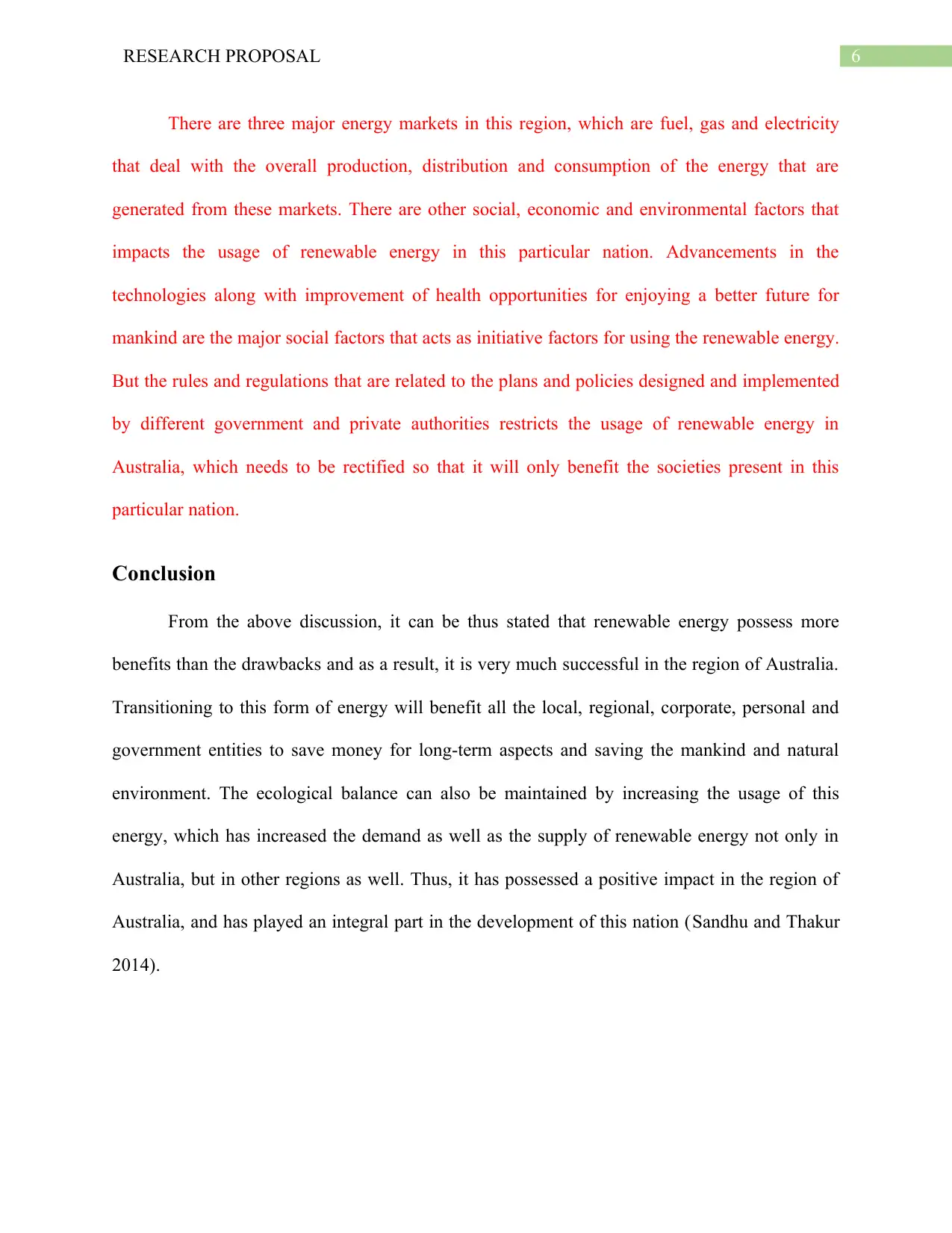
6RESEARCH PROPOSAL
There are three major energy markets in this region, which are fuel, gas and electricity
that deal with the overall production, distribution and consumption of the energy that are
generated from these markets. There are other social, economic and environmental factors that
impacts the usage of renewable energy in this particular nation. Advancements in the
technologies along with improvement of health opportunities for enjoying a better future for
mankind are the major social factors that acts as initiative factors for using the renewable energy.
But the rules and regulations that are related to the plans and policies designed and implemented
by different government and private authorities restricts the usage of renewable energy in
Australia, which needs to be rectified so that it will only benefit the societies present in this
particular nation.
Conclusion
From the above discussion, it can be thus stated that renewable energy possess more
benefits than the drawbacks and as a result, it is very much successful in the region of Australia.
Transitioning to this form of energy will benefit all the local, regional, corporate, personal and
government entities to save money for long-term aspects and saving the mankind and natural
environment. The ecological balance can also be maintained by increasing the usage of this
energy, which has increased the demand as well as the supply of renewable energy not only in
Australia, but in other regions as well. Thus, it has possessed a positive impact in the region of
Australia, and has played an integral part in the development of this nation (Sandhu and Thakur
2014).
There are three major energy markets in this region, which are fuel, gas and electricity
that deal with the overall production, distribution and consumption of the energy that are
generated from these markets. There are other social, economic and environmental factors that
impacts the usage of renewable energy in this particular nation. Advancements in the
technologies along with improvement of health opportunities for enjoying a better future for
mankind are the major social factors that acts as initiative factors for using the renewable energy.
But the rules and regulations that are related to the plans and policies designed and implemented
by different government and private authorities restricts the usage of renewable energy in
Australia, which needs to be rectified so that it will only benefit the societies present in this
particular nation.
Conclusion
From the above discussion, it can be thus stated that renewable energy possess more
benefits than the drawbacks and as a result, it is very much successful in the region of Australia.
Transitioning to this form of energy will benefit all the local, regional, corporate, personal and
government entities to save money for long-term aspects and saving the mankind and natural
environment. The ecological balance can also be maintained by increasing the usage of this
energy, which has increased the demand as well as the supply of renewable energy not only in
Australia, but in other regions as well. Thus, it has possessed a positive impact in the region of
Australia, and has played an integral part in the development of this nation (Sandhu and Thakur
2014).
Paraphrase This Document
Need a fresh take? Get an instant paraphrase of this document with our AI Paraphraser
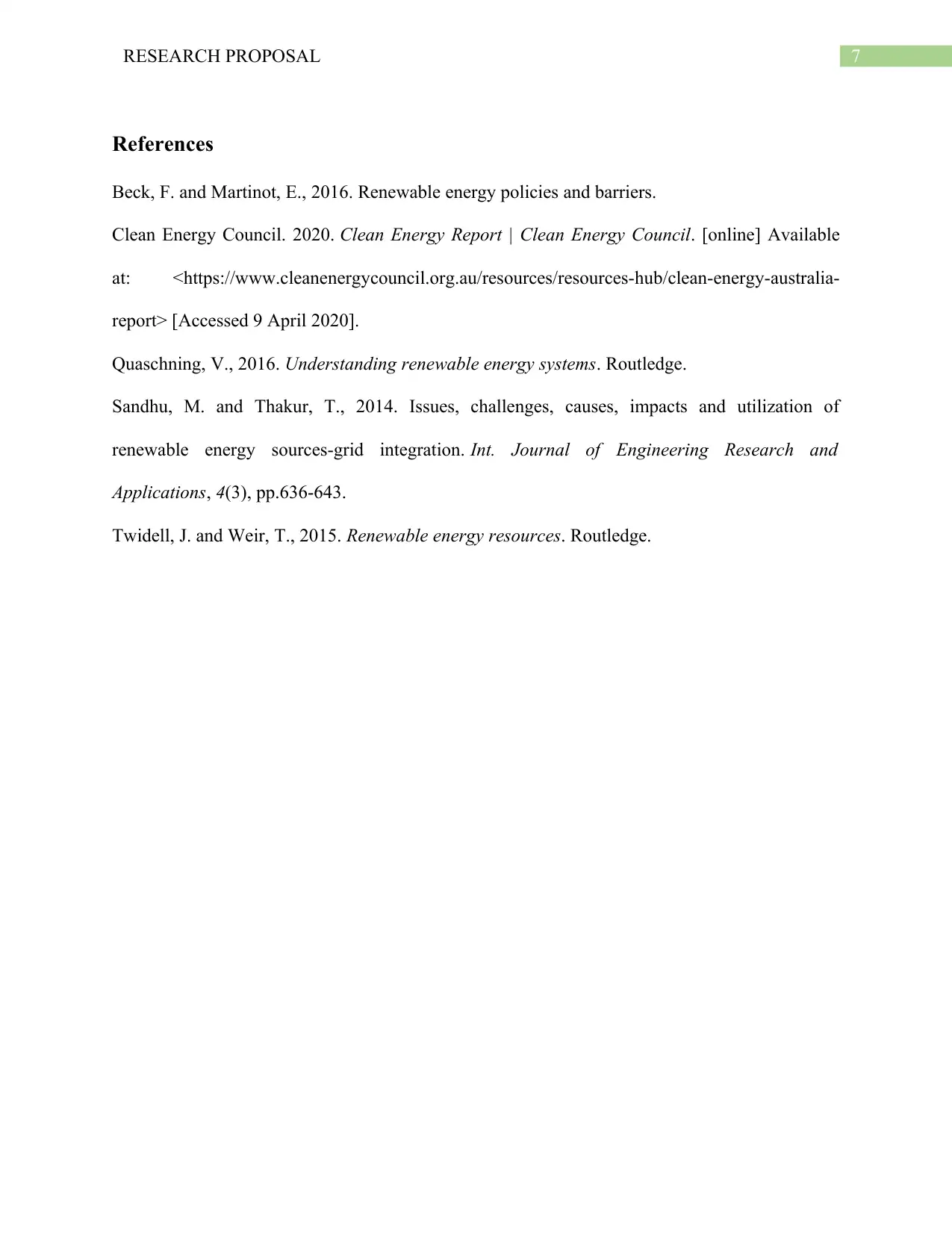
7RESEARCH PROPOSAL
References
Beck, F. and Martinot, E., 2016. Renewable energy policies and barriers.
Clean Energy Council. 2020. Clean Energy Report | Clean Energy Council. [online] Available
at: <https://www.cleanenergycouncil.org.au/resources/resources-hub/clean-energy-australia-
report> [Accessed 9 April 2020].
Quaschning, V., 2016. Understanding renewable energy systems. Routledge.
Sandhu, M. and Thakur, T., 2014. Issues, challenges, causes, impacts and utilization of
renewable energy sources-grid integration. Int. Journal of Engineering Research and
Applications, 4(3), pp.636-643.
Twidell, J. and Weir, T., 2015. Renewable energy resources. Routledge.
References
Beck, F. and Martinot, E., 2016. Renewable energy policies and barriers.
Clean Energy Council. 2020. Clean Energy Report | Clean Energy Council. [online] Available
at: <https://www.cleanenergycouncil.org.au/resources/resources-hub/clean-energy-australia-
report> [Accessed 9 April 2020].
Quaschning, V., 2016. Understanding renewable energy systems. Routledge.
Sandhu, M. and Thakur, T., 2014. Issues, challenges, causes, impacts and utilization of
renewable energy sources-grid integration. Int. Journal of Engineering Research and
Applications, 4(3), pp.636-643.
Twidell, J. and Weir, T., 2015. Renewable energy resources. Routledge.
1 out of 8
Related Documents
Your All-in-One AI-Powered Toolkit for Academic Success.
+13062052269
info@desklib.com
Available 24*7 on WhatsApp / Email
![[object Object]](/_next/static/media/star-bottom.7253800d.svg)
Unlock your academic potential
Copyright © 2020–2025 A2Z Services. All Rights Reserved. Developed and managed by ZUCOL.





